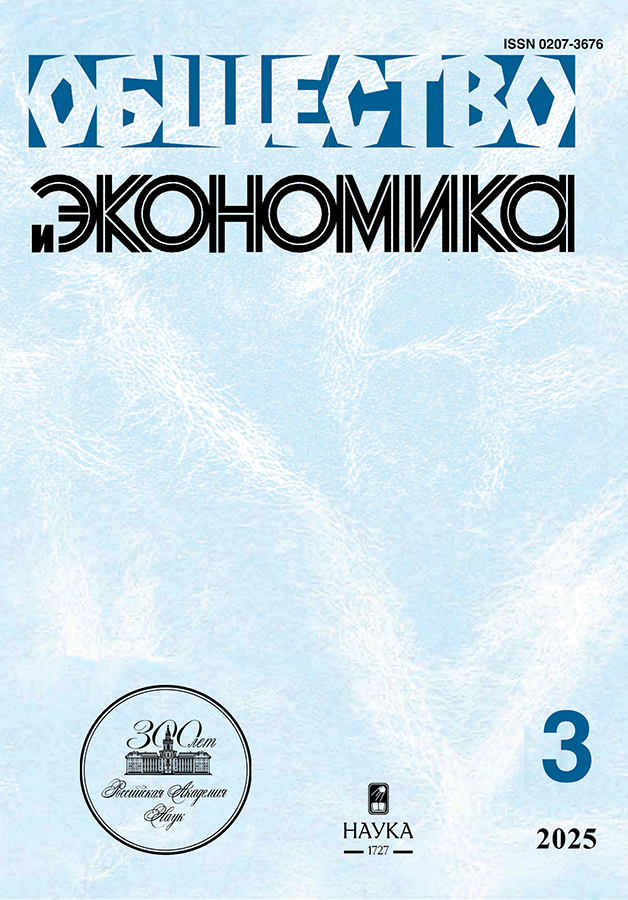Regional features of development of the manufacturing industry of Uzbekistan
- Authors: Mukhsimova D.1
-
Affiliations:
- Institute for Macroeconomic and Regional studies
- Issue: No 3 (2025)
- Pages: 61-70
- Section: REGIONAL DEVELOPMENT
- URL: https://freezetech.ru/0207-3676/article/view/684571
- DOI: https://doi.org/10.31857/S0207367625030054
- ID: 684571
Cite item
Abstract
The article examines the territorial pattern of the ongoing transformation of the manufacturing industry in Uzbekistan. The diversification, localization, concentration, and specialization of manufacturing industries are analyzed, allowing for the assessment of territorial differences in production structure and the competitive advantages of regions. The assessment methods used, including the Herfindahl–Hirschman Index (HHI) and RCA (Revealed Comparative Advantage), allow for a deep characterization of production in 14 regions of the country. The results of the study show that regions with high diversification have more opportunities for economic sustainability, while low degrees of diversification or high concentration of production in certain industries create risks of dependence on a limited number of sectors.
Full Text
About the authors
Dilafruz Mukhsimova
Institute for Macroeconomic and Regional studies
Author for correspondence.
Email: mdh_dimond@mail.ru
Ph.D.in Economics
Uzbekistan, TashkentReferences
- Романов М.Т., Корниенко О.С. Анализ cпециализации и концентрации видов экономической деятельности малых территорий (на примере муниципальных образований Приморского края) // Таможенная политика России на Дальнем Востоке. 2015. № 3(72).
- Корниенко О.С. Изменения концентрации и специализации хозяйственных структур в районах Дальнего Востока // Успехи современного естествознания. 2021. № 8.
- Жайлауов Е.Б., Омар Ж.Т., Улыбышев Д.Н., Петренко Е.С. Экономическая специализация региональных экономических систем Казахстана: методы определения и факторы формирования // Экономика Центральной Азии. 2023. Т. 7. № 2. С. 117–134. doi: 10.18334/asia.7.2.118947
- Ужегов А.О. Индустриальный профиль регионов и возможности их высокотехнологичного развития // Вестник Омского университета. Серия «Экономика». 2023. Т. 21. № 3. С. 118–128. doi: 10.24147/1812-3988.2023.21(3)
- Бикмаева А.Д. и др. Динамика уровня диверсификации экономики регионов. // Вестник Томского государственного университета. Серия «Экономика». 2024. № 68. С. 132–145.
- Федорова Т.С., Афанасьева Л.В. Стратегическая роль диверсификации экономики в обеспечении экономической безопасности в условиях нестабильной внешней среды. ЗАО «Университетская книга». Конференция: цифровая экономика: проблемы и перспективы развития. Курск, 15 декабря 2023 г. Организаторы: Юго-Западный государственный университет. 2023.
- Фурсенко Н.О. Динамика экономической диверсификации регионов РФ // Развитие территориальных социально-экономических систем: вопросы теории и практики: материалы XVI Международной научно-практической конференции молодых ученых Екатеринбург, 12–13 марта 2019 г. / Отв. ред. Ю.Г. Лаврикова. Екатеринбург: Институт экономики Уральского отделения РАН. 2019. С. 282–285. EDN KIBQVB.
- Михеева Н.Н. Структурные факторы региональной динамики: измерение и оценка // Пространственная экономика. 2013. № 1. С. 11–32. EDN SBPPCD.
Supplementary files











